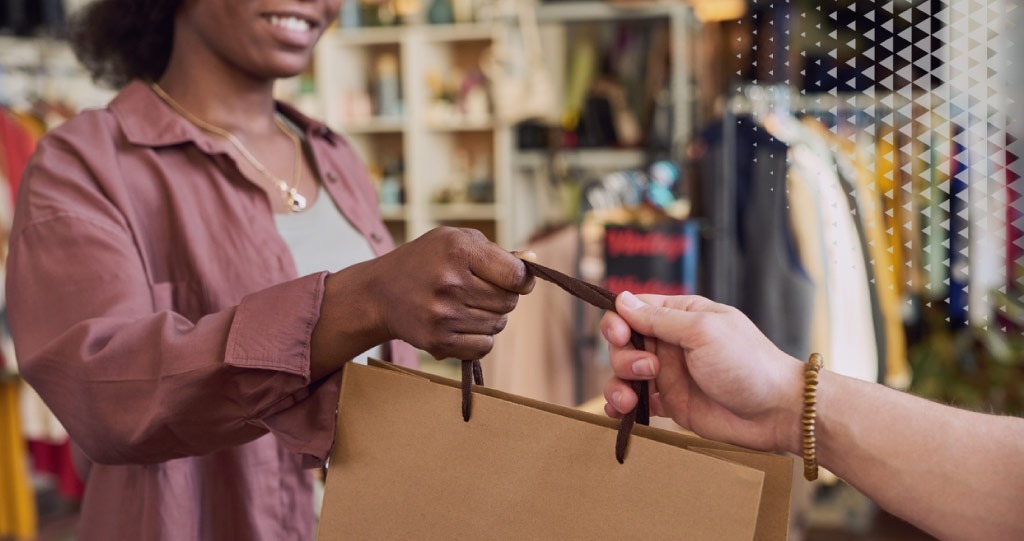Omnichannel second-hand: at the heart of retail transformation

Motivated by the need for meaningful, sustainable, and cost-effective shopping, second-hand sales are fundamentally changing traditional retail models. When paired with an omnichannel strategy, it creates a smooth, consistent, and responsible customer experience.
This article delves into how omnichannel recommerce is reshaping the buying journey and creating new growth avenues for brands.
Recommerce, a sustainable… and profitable lever
Strong consumer demand
Second-hand shopping is increasingly meeting consumers’ needs for responsible purchases and transparency. By 2024, 72% of French consumers had bought a second-hand item, with almost half making monthly purchases.
Their reasons include environmental preservation, extending product life, and saving money, especially for two-thirds of buyers. This trend is particularly popular among younger generations who value usability over ownership.
What consumers expect:
- Consumers expect a consistent omnichannel experience that includes both new and second-hand products.
- They seek assurances regarding the quality and origin of resold items
- A straightforward and transparent process, whether they shop in-store or online.
A market under structuration in retail
The ThredUp report (2025) predicts the global second-hand market will hit $367 billion by 2029. Initially led by specialized platforms such as Vinted and Back Market, traditional retailers are now tapping into this market.
This shift underscores a transformation towards circular economy models buyback, reconditioning, direct resale, and integrated consignment making second-hand a seamless extension of unified commerce.
Why brands should integrate it into their customer journey
Consumers desire an ecosystem where they can buy, resell, or exchange products seamlessly. They look for a circular experience that enhances every stage of a product’s life cycle.
Retailers can leverage this by
- Offering buyback services to drive customer loyalty
- Selling refurbished products to create new revenue streams and strengthen their sustainable brand image.
Initial studies reveal that loyalty programs like “cashback” or “buyback vouchers” boost the likelihood of repeat purchases and enhance loyalty in the second-hand market.
The Back Market example: simple and effective omnichannel
Back Market, initially launched as a marketplace for refurbished technology, has swiftly become a global leader in second-hand tech. Originally connecting professional sellers with buyers, the company has broadened its services to encompass an entire ecosystem.
Depositing a phone in-store
Benjamin, in Paris, notices his smartphone’s battery is unstable and the screen cracked. He learns he can drop his device at a Back Market partner store for an immediate buyback evaluation.
An advisor scans the phone and estimates its worth at €100. Benjamin accepts the offer and leaves his phone, which will soon be reconditioned.
The phone enters the second-hand flow
After Benjamin drops off his phone, the reconditioning process kicks off. The partner store sends the device’s data to Back Market, which forwards it to an accredited center for testing, repair, and quality classification.
Using a centralized infrastructure, each phone receives a unique identifier for tracking throughout its journey. This system ensures visibility from collection to resale, fostering consumer trust.
Another inspiring example: Galeries Lafayette & BHV
Since 2022, Galeries Lafayette and BHV Marais have included second-hand products in their omnichannel strategy by establishing dedicated areas in several stores. Partnering with Reliving and Personal Seller for clothing and accessories, they offer a streamlined customer experience that blends new and second-hand.
Most importantly, the early results are there:
- Their efforts have yielded strong results:
- +15% increase in store traffic where second-hand areas are established;
- A younger customer base, with most shoppers under 35;
- Higher online repurchase rates among customers taking advantage of these services;
- Enhanced loyalty program engagement due to cumulative bonuses on second-hand purchases.
This initiative demonstrates that brands can blend a premium image with CSR goals and business performance by integrating second-hand products into a cohesive omnichannel system.
Key aspects include:
- Visibility both online and offline;
- Integration with CRM and loyalty programs;
- Interconnection with current customer journeys.
What traditional brands should consider
Flows to manage between physical, digital, and partners
Incorporating second-hand items into an omnichannel strategy demands meticulous logistics:
- Coordination among stores, warehouses, and reconditioning partners;
- Synchronizing stocks to guarantee real-time availability;
- Tracking products at every stage using unique identifiers.
Customer data to synchronize
Customer data is crucial in an omnichannel journey that includes second-hand goods. Retailers must identify consumers at any interaction point, necessitating centralized information from various systems.
Unified data creates a single customer view, encompassing both second-hand and new interactions.
Strengthened loyalty logic
Brands can extend their customer relationships by enabling reselling, repairing, or repurchasing within the same ecosystem. Each interaction thus becomes an opportunity for re-engagement. This circular economy model encourages longevity: customers who resell are more inclined to repurchase, particularly when brands simplify the process with tangible benefits.
What an adapted omnichannel solution should allow
Management of buybacks, repairs, and resales
Managing second-hand items necessitates strict coordination between points of sale, logistics partners, and e-commerce platforms. The objective is to deliver an experience as seamless as traditional purchases, ensuring product traceability. A unified platform should facilitate:
- Recording buybacks in-store or online with automatic value estimation;
- Tracking repairs and refurbishments using a unique product identifier;
- Maintaining real-time stock updates.
Integration with existing solutions
An effective second-hand solution must sync with the POS, OMS, CRM, and e-commerce platform to ensure consistent information across all channels:
- The POS records the buyback and updates the stock;
- The OMS manages product movement between warehouses, partners, and sales channels;
- The CRM retains customer history and fuels loyalty campaigns;
- The e-commerce site showcases refurbished products available in real-time.
Omnichannel reporting and loyalty
The omnichannel solution should provide an analytical view of second-hand performance. Reporting is key for measuring profitability, tracking customer behavior, and managing loyalty.
Critical metrics include:
- Volume and value of buybacks versus refurbished sales;
- Average credited and reused cashback;
- Repurchase rate and its impact on customer loyalty.
Additionally, centralized cashback and loyalty program management reinforce the journey’s coherence. Customers can drop off items in-store, receive instant credit, and use it online or at another store. With clienteling tools, advisors gain a complete view of the customer profile, allowing them to personalize interactions and recommend appropriate refurbished products.
Thus, a brand that can unify sales, buybacks, and rewards delivers a smooth customer experience and achieves a sustainable competitive edge.
Recommerce + omnichannel: benefits at stake
Attracting new customers
Kiabi and Kidkanaï have shown that recommerce attracts consumers who value sustainability, fair pricing, and transparency. By integrating these expectations into a unified experience, brands increase their appeal.
Second-hand serves as an accessible entry point, enabling new customers to discover the brand through refurbished or second-hand products, eventually leading to new ones.
Reducing acquisition costs
Implementing an omnichannel second-hand offer helps lower customer acquisition costs. Brands can cut marketing expenses while enhancing their perceived value.
Recommerce utilizes existing assets: loyal customers, returned products, dormant or unsold stocks. Each reclaimed item adds a touchpoint, driving traffic to stores or e-commerce sites.
Stimulating sales and customer engagement
Incorporating second-hand into an omnichannel strategy creates a positive feedback loop between engagement and conversion. Brands can increase interactions throughout the customer lifecycle, turning each exchange into a purchase opportunity.
Customers committed to this circular approach are likelier to remain active, frequently checking their personal space, tracking cashback, and availing offers. This ongoing engagement boosts both purchase frequency and average cart value.
Effects of recommerce on performance
- Higher repurchase rates driven by buyback credits;
- Increased engagement through personalized and responsible journeys;
- Enhanced emotional connection between brand and consumer.
Why not take action?
3 tips for launching your omnichannel recommerce project
1. Begin with a controlled pilot
Choose a specific product segment or test location to validate processes before scaling up.
2. Connect your existing systems
Guarantee seamless communication among your tools for centralized data and a coherent omnichannel experience.
3. Highlight the approach to the customer
Clearly convey details about buybacks, price transparency, and environmental advantages. Establish a rewarding journey with cashback, loyalty benefits, and product traceability.
Example of Geev Shop
Geev, known for its donation app, introduces Geev Shop—a physical space dedicated to free second-hand items. This model connects digital and physical store environments around a circular, non-monetary concept.
Lifecycle of an item at Geev Shop
- Membership: Create a Geev account.
- In-store drop-off: The item is registered and shelved.
- Availability: The item is accessible to members and finds a new owner.
- Credit access: Depositors can retrieve up to 5 items per week from the store.
Why equip yourself with a solution like Orisha Commerce
Deploying an omnichannel second-hand offer necessitates technology that unifies processes and data. Orisha Commerce’s integrated ecosystem centralizes stock management, orders, and flows between new and second-hand products. Brands can manage buyback, resale, and delivery operations in real-time while offering a coherent customer experience.
Two models, the same ambition: integrating second-hand into a smooth omnichannel journey
|
Criteria: |
Back Market: Pure player transitioning to phygital |
Galeries Lafayette/BHV: Established retailer |
|
Starting point |
Digital native (100% e-commerce) |
Premium physical retail |
|
Initial objective |
Enhance customer closeness |
Address CSR goals and attract a younger demographic |
|
Second-hand offer |
Buyback at partner stores plus cashback |
Dedicated physical corners with external partners |
|
Omnichannelity |
Cashback usable online; fully connected journey |
Buy/sell in-store with cross-channel loyalty benefits |
|
Technology used |
POS and e-commerce integration plus unified customer account |
CRM with omnichannel loyalty program interfacing |
|
Results observed |
Rise in repurchase rate and enhancement of customer value |
+15% store traffic increase and higher online repurchase rates |
|
Priority target |
Young urban, tech-savvy consumers |
Affluent customers attuned to the circular economy |
|
Strategic lever |
Smooth transactions and self-service |
Brand image and unique experience |
Key points: Two different models, but the same strategic foundation
- Unified flow management.
- Personalized customer relationships.
- Connecting buyback, sales, and loyalty channels.
Regardless of a brand’s maturity, a well-executed omnichannel recommerce project can:
- Generate traffic.
- Enhance customer experience.
- Strengthen loyalty.
- Activate new profitability levers.
Frequently asked questions
How is the second-hand market evolving?
The second-hand market is thriving and projected to reach $367 billion by 2029. Major brands are increasingly participating, turning second-hand into a structured and profitable retail segment.
Which categories dominate the second-hand market?
- – Clothing and fashion accessories.
- – Smartphones and electronics.
- – Furniture and decor.
- – Sports equipment.
What are the advantages of omnichannel second-hand sales?
- – Seamless customer experience across buyback, resale, and purchase channels.
- – New revenue streams through product value enhancement.
- – Sustainable brand image meeting consumer expectations.
- – Increased loyalty with cashbacks and integrated circular journeys.
- – Enhanced customer insight through centralized data for new and refurbished products.
How do brands incorporate second-hand into their strategy?
Brands incorporate second-hand into their strategy through various methods:
- – Dedicated resale or drop-off spaces in-store.
- – Online platforms linked to their primary e-commerce site.
- – Buyback programs with immediate value estimation and vouchers.
- – Partnerships with specialized reconditioning or recycling organizations.




